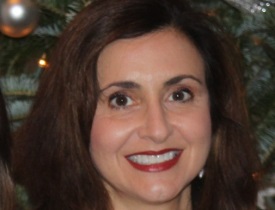Making the Case for Pulmonary Rehabilitation
Posted on November 02, 2018 |

Cristin Trecroce is a healthcare professional and COPD Foundation State Captain from North Carolina. As a COPD advocate, she hopes to spread awareness about the importance of pulmonary rehabilitation for COPD patients. Read her blog posting below, to learn more about pulmonary rehabilitation and its benefits.
Water amazes and scares the daylights out of me. If I think about swimming while in the water, I panic. What if my lungs run out of air while I am swimming? What if I inhale the water and can’t breathe? I can sink, if I sink, I can die. Hello, I can die! What if you had to worry about your breathing all the time, not just when you were in water? Millions of people with COPD have to do this. They have to focus on their breathing as if they were underwater negotiating between the energy needed to breathe and the energy needed to swim or function. About 30 million people in the United States have COPD with half of these 30 million not even realizing they have the disease. The half that is undiagnosed, go throughout their days, compensating for their symptoms without recognizing that their lungs are changing. COPD can cause changes to the lungs that can be subtle at first but then progress to outright lung failure.
Exacerbations of the disease can happen over time or abruptly, when the body’s lung limitations become overwhelmed. Overwhelming stressors can be from illnesses (like a cold or flu) or another health condition. If this happens repeatedly, the lungs get weaker. The weaker the lungs get, then the more likely COPD exacerbations can happen. The process can continue, like a chain reaction, resulting in disability.
November is COPD awareness month. During this month take a few minutes to focus on your breathing. Likely your breathing is something you don’t think much about, but rather take for granted. What would it be like if you had to really focus on your breathing while simultaneously doing big tasks? Would you get dressed in the a.m., make your own meals, shop or socialize? Probably not. If you feared losing your breath, you would naturally avoid difficult tasks. This is why COPD leads to shame, social isolation and poor nutrition.
There is help available. Although there is no cure for COPD there are options for managing the disease. Treatments for COPD include medications, oxygen, physical therapy and sometimes surgery. The best treatment starts after a proper diagnosis is made by a pulmonary function test. This test measures the lungs’ capacity to fully take air in and blow it out. Pulmonary function tests do not require needles or any special equipment. They can be done at a doctor’s office by breathing into a tube. Once the diagnosis of COPD is established (based on the breathing test results and symptoms) the journey to help begins.
My favorite treatment option for COPD is pulmonary rehabilitation. Here patients learn practical strategies for managing their breathing while performing daily routines. Each individual in pulmonary rehabilitation receives an exercise program specifically designed for them based on their lung and muscle capacity. Programs are developed by a team that includes a social worker, nutritionist, respiratory therapist, exercise specialist and physician. Exercise at pulmonary rehab is carefully monitored to make sure participants are safe. There are social benefits to participating in pulmonary rehabilitation, as it brings together individuals going through similar circumstances who can share ideas and experiences that are unique to them. Pulmonary rehabilitation teaches classes on handling of airway secretions, energy conservation, smoking cessation, safe exercise techniques, proper use of medication and oxygen and stress management. The classes and unique exercise training help COPD patients regain and maintain independence in a safe environment tailored specifically to their individual needs.
If you encounter anyone who has COPD, ask them to consult their doctor to find out if pulmonary rehabilitation is available to them. If you notice someone with chronic cough and shortness of breath, who has not yet been diagnosed with COPD, encourage them to get a pulmonary function test. COPD leads to long term disability, loneliness, anxiety, nutrition deficiencies and hospital admissions. Better disease management starts with disease awareness and recognition. Starting this month, spread COPD awareness and be a part of a chain reaction to better breathing.